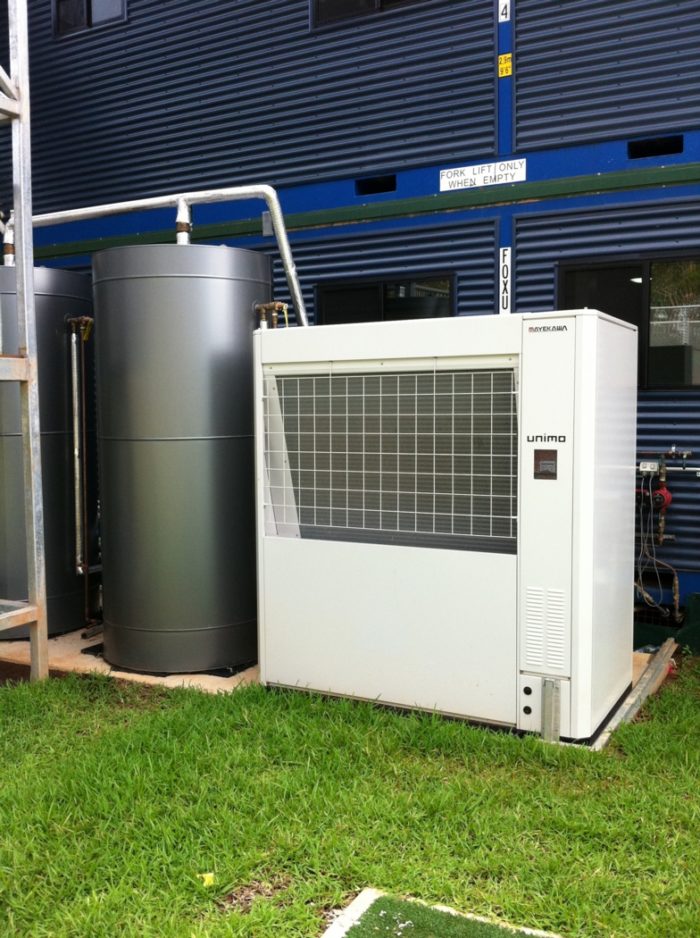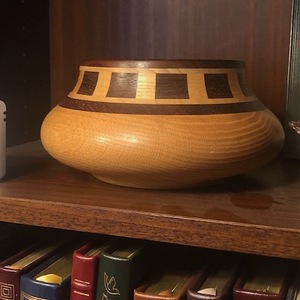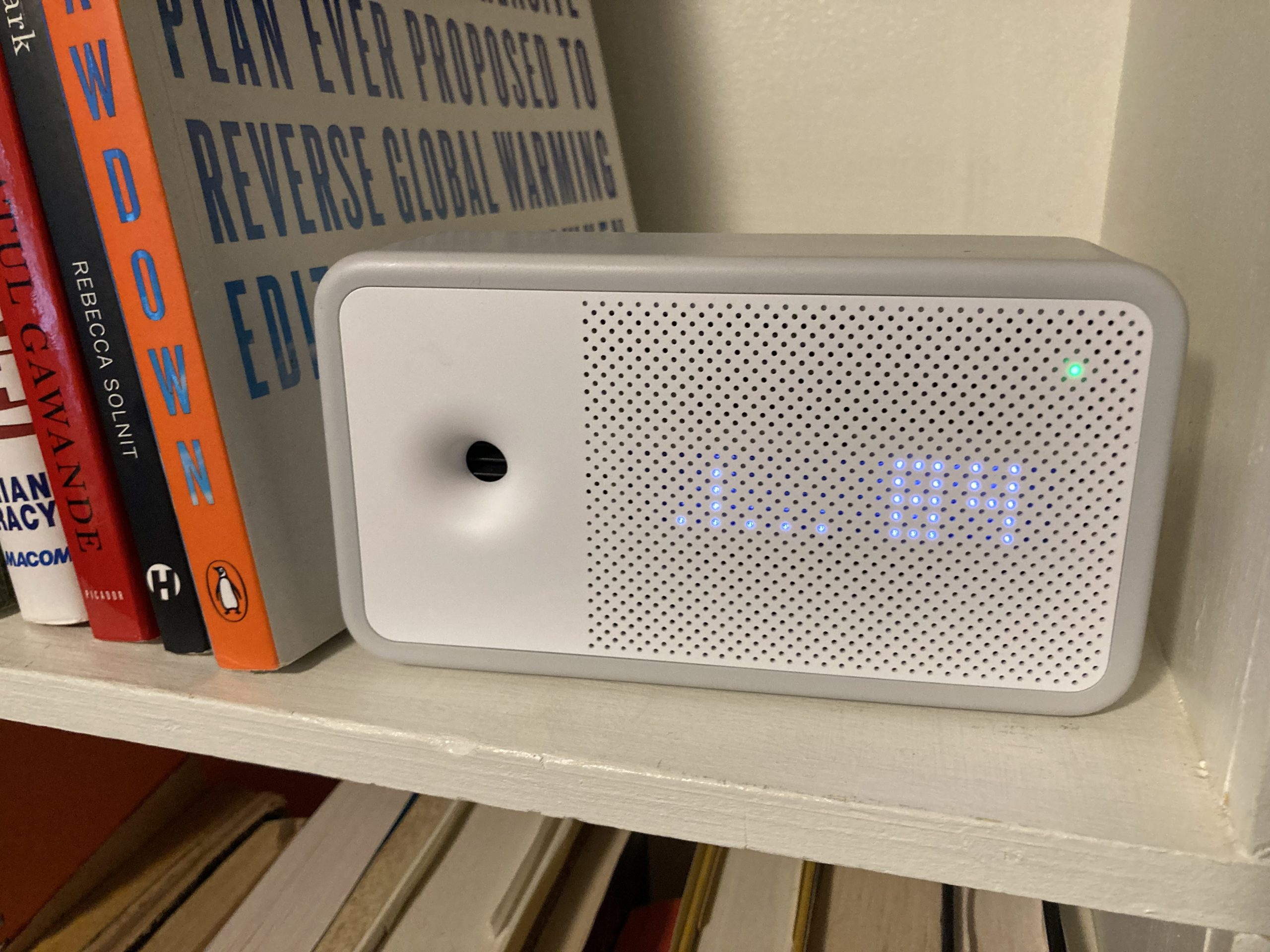Image Credit: Mayekawa
Image Credit: Mayekawa An EcoCute water-to-water heat pump (next to the large tank) at the Somerston Winery in Napa Valley, California. Detail of the EcoCute heat pump at the Somerston Winery, showing a large buffer tank. An EcoCute installation in Quebec, Canada with multiple units.
In researching and writing about building products for our publication Environmental Building News over the past twenty-plus years I’ve had an opportunity to cover some fascinating breakthrough products and technologies. One such technology I was writing about a few weeks ago is the use of carbon dioxide as a working fluid for heat pumps.
But let me back up with a little context about refrigerants. These are the fluids used in refrigerators, air conditioners, and heat pumps that transfer heat from one place to another in cooling or heating a space. This “vapor-compression-cycle” equipment takes advantage of the principle that compressing a gas absorbs heat and expanding it releases heat — so it’s a way to move heat from one place to another.
When this compression and expansion cycle results in a phase change (converting it from liquid to gas or vice versa), significant heat can be absorbed and released.
Weekly Newsletter
Get building science and energy efficiency advice, plus special offers, in your inbox.
Problems with refrigerants
Over the past 35 years, refrigerants have come under fire — both for their impact on the Earth’s protective ozone layer and for their global warming potential (GWP). HCFC-22 (R-22), a hydrochlorofluorocarbon, has long been the most common refrigerant. But it is being phased out according to the international treaty to protect the Earth’s protective ozone layer.
That’s a good thing, as R-22 is both a significant ozone depleter and a significant greenhouse gas. The HFC (hydrofluorocarbon) refrigerants that have replaced HCFC-22 are much better from an ozone-depletion standpoint (ozone depletion potential or ODP of 0), but they are still very significant greenhouse gases (high GWP).
Using CO2 as a refrigerant
These concerns with HCFC and HFC refrigerants have led to interest in other chemicals that can be used as refrigerants, one of which is carbon dioxide (CO2). The Japanese have focused considerable attention on CO2-based heat pumps, and one Japanese company, Mayekawa, has been selling commercial-scale CO2-based heat pumps in North America for several years.
Mayekawa offers three different CO2 heat pumps, the EcoCute water-to-water heat pump, the Unimo air-to-water heat pump (PDF download) and the Sirocco water-to-air heat pump. (The product name, EcoCute, got a little bungled in translation from the Japanese. “Eco” is short for “ecological” in the U.S., while ”cute” is derived from a Japanese kyÅ«tÅ, meaning “supply hot water.”) The term “EcoCute” is used generically by a number of Japanese manufacturers, whose development efforts were funded by the government and the utility company TEPCO.
All three of the Mayekawa heat pumps have 25 kilowatt (kW) motors, so they are considerably larger than the heat pumps used for homes.
High efficiency is an important benefit of such systems; they operate at a coefficient of performance (COP) of about 4.0. If they are configured to provide space cooling in addition to hot water (just the water-to-water and air-to-water models), the COP can be as high as 8.0.
Higher output temperatures
From a performance standpoint, the big difference with CO2-based heat pumps is that they can produce much higher-temperature output. Exactly why they can do this is complex and has to do with CO2 being a “transcritical” refrigerant and doesn’t fully change phase like other refrigerants — I’ll spare you the details here, though I describe it in the article on Mayekawa heat pumps that I wrote for the August issue of Environmental Building News (requires subscription to BuildingGreen.com).
The EcoCute water-to-water heat pump and the Unimo air-to-water heat pump can produce water at up to 194°F — far hotter than that produced by standard heat pumps. This is significant, because it makes them viable for hydronic (baseboard hot-water) heating. As my friend and energy engineer Marc Rosenbaum, P.E. told me, if this can be done affordably, it will be a “game changer.”
One challenge with CO2-based heat pumps is that they need a fairly large lift temperature to operate. This is the difference in temperature in a heating loop between the supply and return temperature.
A standard gas- or oil-fired boiler may deliver 180°F water for hydronic heating, and return water in the heating loop at a temperature of 150°F after delivering its heat through baseboard radiators. So the boiler has to “lift” the water from 150°F to 180°F. That isn’t enough lift for a CO2-based heat pump. The EcoCute needs a minimum of about 45°F of lift to function effectively.
Higher pressure
The other challenge is that CO2 refrigerant cycles operate at far higher pressure than standard vapor-compression-cycle equipment. At the evaporator side the pressure can be about 600 pounds per square inch (psi), while in the gas cooler (which replaces the condenser in a standard compression-cycle device), the pressure can be 1,500 to 1,800 psi.
The higher pressure and the need for more robust (and more expensive) components to contain that pressure has slowed the development of CO2-based heat pumps.
The future of CO2-based heat pumps
I gather that several manufacturers of popular minisplit heat pumps are developing residential-scaled CO2-based heat pumps and that those heat pumps are currently undergoing testing.
It will be fascinating to see what emerges. What excites me is that such heat pumps increase the potential of providing more of our energy needs using electricity generated by sunlight as an alternative to burning fossil fuels. There are challenges, certainly, but such products could help us transition to a solar future.
Alex is founder of BuildingGreen, Inc. and executive editor of Environmental Building News. In 2012 he founded the Resilient Design Institute. To keep up with Alex’s latest articles and musings, you can sign up for his Twitter feed.
















10 Comments
Good overview
Nice overview of CO2 as a refrigerant, Alex. You made one statement at the beginning, though, that's not quite correct.
Compressing a gas increases the temperature and expanding it lowers the temperature. That's not equivalent to adding or removing heat, two processes that happen in the evaporator and condensing coils, respectively. It's the phase changes that are responsible for adding or removing heat, not the compression and expansion.
The compression and expansion are necessary to get the temperature of the working fluid high enough or low enough so that the Second Law of Thermodynamics can take over. Heat flows from higher temperature to lower temperature, you know.
I wrote up a detailed explanation of the vapor-compression (a.k.a. refrigeration) cycle a couple of years ago:
The Magic of Cold
Others looking to CO2 as well
A recent kickstarter project sought to capitalize on CO2 as its working fluid. http://www.kickstarter.com/projects/1876426552/supercritical-co2-turbine-generator?ref=category
Perhaps the two could be combined.
Sanyo...
...has been marketing a residential CO2 refrigerant air to water heat pump system in Europe for more than a half-decade now:
http://www.elektricno-ogrevanje.si/db/file/SANYO_CO2_ECO_v2.pdf
http://www.transitionedinburghsouth.org.uk/blog/sanyo-co2-eco-air-source-heat-pump-operation
At 9kw of thermal output (30,000 BTU/hr) it's on the small side for a McMansion, but big enough to heat an ~2500' IRC 2009 code-min house in US climate zone 5 (and many in zone 6.)
It's not clear to me what's keeping them from the north American market, other than the demand for air conditioning (air-to-air R410A systems are an easier sell here.)
This is not new technology, and I expect it to displace R410A for many applications in the not too distant future, especially after R410A becomes more regulated as a greenhouse gas, since it's GWP (~2088x CO2) is even higher than R22 (~1810x CO2) on a 100-year basis. CO2 has recently become the new standard displacing HFC134a (~1400x CO2 GWP) in Europe for automotive air conditioning applications- more of this technology is coming.
Martin's next article...
Dana, if those Sanyo (now Panasonic?) units or similar ever come stateside, Martin will be able to write another article - "Solar Thermal is (REALLY) Dead".
Sanyo CO2 heat pumps
Dana,
I also saw Sanyo literature on these residential CO2 heat pumps a few years ago, but I haven't seen anything on them since Panasonic acquired Sanyo. Do you know if this CO2 heat pump product line has been continued in Europe?
carbon sequestration?
Often think and hear about carbon sequestration as a method to lower carbon footprint etc...
I suppose this wouldn't go to far in that department.... ? not to many lbs of refrig. in an system...
and/or they would make co2 to put in these instead of capture...lol
But i suppose on a larger commercial application - could be slightly significant - if installed in hundreds of locations.
The high delta T requirements are interesting, would be interesting to design around that .
Panasonic discontinued the Sanyo system, kept the technology
See: http://www.r744.com/companies/view/panasonic (looks like commercial applications only)
Somehow I'd missed the closing of that product line. The pieces of the technology are still there, but apparently no longer bundled & marketed as a home-heating system. Panasonic had a competing "Aquarea" air-to-water heat pump system using R410A launching in Europe shortly after the take over to compete directly against Daikin's Altherma air-to-water heat pump systems (also R410A), and that may have been a factor in the discontinuation. See: http://www.pmcoppack.com/shop/datasheets/product_datasheets/Aquarea.pdf
SFAIK the Panasonic Aquarea is not (yet) marketed in N.America either (but the Daikin Altherma is.)
The University of Strathclyde engineering department had run the Sanyo system through a series of testing, the highlights of which can be found here:
http://www.esru.strath.ac.uk/EandE/Web_sites/10-11/ASHP_CO2/introduction.html
http://www.esru.strath.ac.uk/EandE/Web_sites/10-11/ASHP_CO2/lit-sanyoEcoCute.html
Efficiency?
The data I've seen indicates that for typical uses, CO2 produces lower efficiency than R410A. Isobutane seems to show better results.
lower efficiency is just one aspect...
Yes, CO2 is below R410A & R22 systems for low temp systems, but for higher temp operation where those HFC system efficiencies fall off CO2 has a very distinct edge. One of the issues for designing efficient heat delivery systems with CO2 is the requirement for delta-Ts greater than 25C on the refrigerant loop, a constraint not shared by fully phase-changing refrigerants as opposed to vapor-only refrigerant systems.
radiant panel before heat pump
Maybe if CO2 need a greater delta, route the returns into a radiant panel after the baseboards to drop the return temp.
Log in or create an account to post a comment.
Sign up Log in